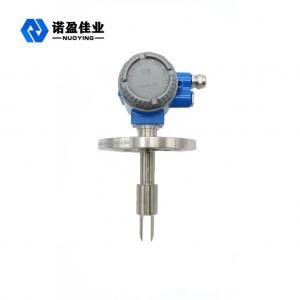

Add to Cart
Easy To Install And Use Tank And Pipe Density Measurement NYDE-CR Tuning Fork Densitometer
NYYC-MD type insertion densitometer can be used for real-time online density detection. It can be used in the process control of products with density as the basic parameter or quality control with solid percentage or concentration percentage as the reference. Using the insertion type installation, widely used in pipelines, open tank containers and closed tank containers in the media density detection fluid density depends directly on the vibration frequency received by the tuning fork inserted into the medium. Sensor built-in temperature sensor to provide temperature compensation. Widely used in petroleum, chemical, brewing, food, pharmaceutical and mineral processing (such as clay, carbonate, silicate, etc.), specific applications in the above industries in the multi-product pipeline interface detection, stirring mixture density detection, reactor endpoint monitoring, ionizer interface detection.
NYDE-CR Tuning Fork Densitometer Working Principle
The sensor works on the principle of component vibration, the component part being the tuning fork part immersed in the measured liquid. The tuning fork part senses the vibrations through an intrinsic piezoelectric device fixed at the bottom end of the fork body. The vibration frequency is detected by a secondary piezoelectric device fixed at the other end of the fork, and then the signal is amplified by a circuit at the top. The density of the liquid and the frequency of vibration when the measured liquid flows are closely related, and when the density of the measured liquid changes, the frequency of vibration when the liquid flows also changes. Through the equation D=Ko+KIT+KETz, the density of the measured liquid can be calculated accurately.
D = density of the measured medium without calibration (kg/m³)
T = frequency of vibration (μs).
Ko, Ki, K2 = constants
In the density detection process, NYYC-MD plug-in densitometer can automatically compensate for the effect of temperature on the density of the measured medium (D), and the pressure has no significant effect on the density.
NYDE-CR Tuning Fork Densitometer Technical Parameters
| Typical application | Tank and pipe density measurement |
| Housing material | Cast aluminum |
| Measuring range | 0.5~2.5g/cc(500–2500kg/m³) |
| Calibration range | 0.5~2.5g/cc(500–2500kg/m³) |
| Power supply | 24VDC,≥50 mA |
| Signal output | 4~20 mA,0~1000Hz,RS485 Modbus RTU |
| Operation temperature | -50~+200℃ |
| Maximum working pressure | 207 bar (3000 psi) |
| Process connection | ANSI 150 to 1500 RF, DN 50 PN16, DN 50 PN40, IDF and RJT sanitary type |
| Joint material | 316L, stainless steel, Hastelloy |
| Fork body coating | Standard, PTFE, electrolytic polishing |
| Protection level | IP67 |
| Explosion-proof grade | Exia II CT6 |
| Housing Type | Electric blue cast aluminum case, bright yellow cast aluminum case, stainless steel case |
NYDE-CR Tuning Fork Densitometer Design Feature
1. Suitable for tanks, pipelines, flowing or stationary media density measurement. Suitable for measuring high temperature, low temperature, high viscosity media containing impurities.
2. Microprocessor-based electronic conversion device, integrating signal processing, calculation and diagnostic functions.
3. Continuous online measurement of liquid density and temperature, high precision, more secure and reliable, can be directly used for production process control.
4. It can communicate directly with PC through RS485 interface, and users can directly perform online node configuration, fault diagnosis and data logging on it.
5. While measuring density and temperature, basic density, concentration percentage, mass percentage, volume percentage and other parameters can be calculated.
6. Excellent overpressure protection structure, superior temperature stability, fully welded seal, robust and reliable design.
7. Easy to install and use, insert the liquid to display the reading.
8. Simplified maintenance, no regular cleaning.
9. Calibration without standard reference source, no laboratory calibration, no process interruption.
10. Intrinsically safe for hazardous sites, hygienic for food production sites.
